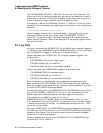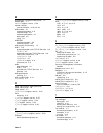
M
Management information base (MIB), 1–1
Master agent, 1–1
mem2oct
support routine, 5–52
method routines
routine reference, 5–19 to 5–24
MIB browser, 4–1
command examples, 4–6
command flags, 4–2
command parameters, 4–1
data types, 4–5
using, 4–1
MIBCOMP
command example, 3–6
command syntax, 3–5
MIB compiler functionality, 1–7
MIB II, 2–5
groups supported under TCP/IP Services, 2–6
ifTable
, 2–7
objects defined under TCP/IP Services, 2–6
restrictions to definition, 2–6
sysObjectID
, 2–6
sysORTable
, 2–7
sysORTable
object, 2–6
tree structure, 3–2
MIBs
Host Resources, 2–1
MIB II, 2–5
provided with TCP/IP Services, 2–1
subtrees, 3–2
MIB specifications
creating, 3–1
MIB variable fields, 3–10
mosy
utility, 3–7
O
Object identification codes (See OIDs)
Object library files, 1–6
Object tables, 3–7
oid2instance
support routine, 5–42
OIDs
assigning, 3–2
o_counter
support routine, 5–37
o_integer
support routine, 5–31
o_octet
support routine, 5–33
o_oid
support routine, 5–34
o_string
support routine, 5–35
P
_ _parse_progname
support routine, 5–64
_ _print_varbind
support routine, 5–60
Problems
See Troubleshooting features
R
_ _restore_progname
support routine, 5–63
RFCs
1155, 2–7, 3–1, 3–2, 4–6
1213, 2–5
1514, 2–1, 2–5
1901 - 1908, 1–8
1902, 3–1, 3–2, 4–6
1907, 2–6, 2–7
2089, 1–8
2741, 1–2
S
*_set
method routine, 5–22
set_debug_level
support routine, 5–57
_ _set_progname
support routine, 5–62
set_select_limit
support routine, 5–61
SMI, 3–1
assigning ID codes, 3–2
hierarchical tree structure, 3–1
registering ID codes, 3–2
snmpi
utility, 3–7
sprintoid
support routine, 5–39
str2oid
support routine, 5–38
Structure of management information
See SMI
Subagent error limit, 6–1
Subagents, 1–1
including in startup and shutdown, 3–12
writing, 1–5, 3–5
Subtrees, 3–2
registering, 3–4
subtree_TBL.C output file, 3–9
subtree_TBL.H output file, 3–7
support routines
routine reference, 5–30 to 5–65
sysObjectID
, 2–6
sysORTable
, 2–7, 5–12
sysORTable
object, 2–6
T
Timeout, default, 6–1
Trap messages
data types, 4–5
receiving, 4–13
sending and receiving, 4–8
setting up a trap service, 4–12
Trap receiver, 4–1
command parameters, 4–12
examples, 4–13
running, 4–12
Trap sender, 4–1
command examples, 4–11
command flags, 4–10
Index–2


















